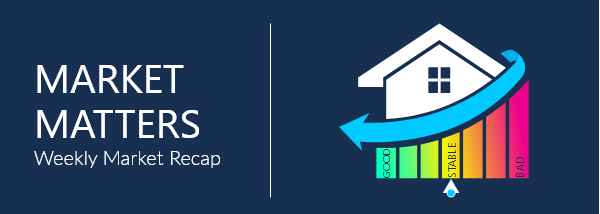Market Matters

We saw a busy week with month and quarter end, along with June’s jobs report in the shortened trading week. With the strong beat in June’s jobs number, we head into the holiday weekend with MBS up slightly, 10-year slightly up and U.S. stocks up around 1%, showing that we have enough good news to push stocks higher, while there is enough doubt with the re-opening of the economy to keep bonds from selling off. As we look to next week, the markets are still trading off of new Covid-19 case count, specifically in the hot spot states, along with the economic re-opening data.
 Initial Jobless Claims
Initial Jobless Claims
Initial jobless claims for the week ending June 27th fell by -55k to 1.427mln, down from the prior week’s revised 1.482mln (orig. 1.48mln). Claims have now fallen for 13 consecutive weeks; however, the declines have only averaged -46k vs. the prior week. That is only a -3% drop, and forecasts say that claims would not drop under the 1mln mark until after Labor Day if that trend continues. Continued claims, which lag a week, rose by +59k to 19.29mln vs. expectations of a -522k drop, so there is noise here. However, the labor department did revise the prior week continued claims lower by -291k to 19.231mln from 19.522mln. Again, we would think we see some positive revisions, but given the recent increase of new Covid-19 cases, it is a very good possibility that claims could be on the rise again.
 Nonfarm Payrolls
Nonfarm Payrolls
Non-farm payrolls for June completely crushed expectations by roughly +1.6mln more jobs. Consensus expectations were for +3.2mln new jobs vs. the headline result of +4.8mln, while private payrolls posted +4.767mln vs. consensus of +3mln. The main driver was that of leisure and hospitality sector, which gained +2.1mln jobs. Strong gains were also seen in retail (+740k), education and health (+568k), manufacturing (+356k), and construction (+158k). On the earnings side, we do see a stronger decline of -1.2% vs. a -.8% consensus, with the YoY print now at +5% vs. consensus of +5.3%. The average workweek fell -.2 at 34.5hrs. In the household survey, the unemployment rate fell to 11.1%, as employment jumped +4.94mln and unemployment fell by -3.235mln. The labor participation rate increased by +.7% to 61.5%, and the employment-population ration increase +1.8% to 54.6%. Both numbers still remain well below where we were roughly 4 months ago, 63.4% and 61.1%, respectively. The BLS did note more ‘misclassification’ issues as workers who still have jobs but have not been working are being counted as employed, even though they are supposed to be considered unemployed under BLS rules. However, the BLS said that this discrepancy “declined considerably” in June vs. April and May, making the actual unemployment rate just over percentage point higher than the reported level. Overall, another strong report that will likely boost arguments for a potential ‘V’ shaped recovery, however, there's also a significant amount of risks that a second-wave of the virus could reverse some of these job gains in July.
 ADP Private Payrolls
ADP Private Payrolls
ADP private payrolls rose by +2.369mln in June, just below the 2.5mln estimates. However, May’s print was significantly revised higher from an originally reported loss of -2.76mln to a gain of +3.065mln. ADP has not given out any details to explain the huge revisions. Back to the June numbers, the leisure and hospitality industry saw a strongest rebound, adding +961k jobs. In addition, construction added +394k, and manufacturing rose by +88k. On the services side, trade/transportation/utilities added +288k, education and health services added +283k, while professional and businesses added +151k, and financial activities were up +65k. Overall, small businesses added +937k jobs, leading the way of any sector. “Small business hiring picked up in the month of June,” said Ahu Yildirmaz, Vice President and co-head of the ADP Research Institute. “As the economy slowly continues to recover, we are seeing a significant rebound in industries that once experienced the greatest job losses.”
 Pending Sales
Pending Sales
Pending home sales in May jumped by +44.3% vs. expectations of only a +19% increase, and vs. the -22% decline back in April. This is now the largest one-month increase in the 19yr history of the survey. Looking YoY, sales were still weaker by -5.1% compared with May 2019, and while May’s increase was a nice surprise, the index at 99.6 is still well below the 111.4 print seen back in February. Regionally, pending home sales in the Northeast rose +44.4% for the month, but were down -33.2% from a year ago. In the Midwest, sales rose +37.2% monthly and were down -1.4% annually. Sales in the South increased +43.3% monthly and were up +1.9% from May 2019. In the West sales jumped +56.2% monthly and were down by -2.5% annually. “This has been a spectacular recovery for contract signings and goes to show the resiliency of American consumers and their evergreen desire for homeownership,” said Lawrence Yun, NAR’s chief economist. “This bounce back also speaks to how the housing sector could lead the way for a broader economic recovery.”
